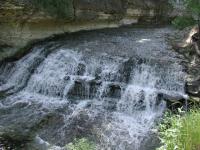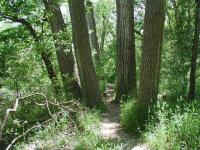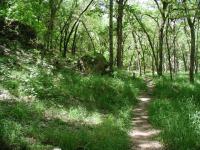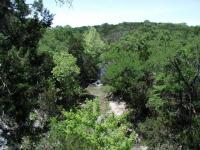-small.jpg)
The first portion of the trail is paved, but some rougher stuff lay ahead.
Exit from I-35 and head west on FM 2484 for about one
mile. Turn right onto FM 1670 and head north for 3.5 miles. Look for the park entrance
on the right. Proceed down the winding driveway to the parking area near the trailhead.
The Hike: The trails at Chalk Ridge present something of a mystery.
At the trailhead, marked on the map by a waypoint of the same name, one finds an interpretive sign pointing out some of the animals one might find on the hike, but no trail map. So I set about mapping as much of the trail as I could in the time I had. Little did I realize that I would map a bit more than planned.
-small.jpg)
A winding boardwalk conveys the trail across a wide creek bed near the start of the hike.
The trail starts off along a straight berm overlooking the Lampasas River to the left.
The gravel surface here through the falls provides a very easy hike for those who are looking
for a simple stroll. At perhaps a quarter mile into the hike a large wooden bridge
provides a passage over a stream bed that empties into the river. Just over a small
ridge lies the crown jewel of the park, the falls from which the park derives its name.

Chalk Ridge Falls, the feature that gives its name to the park that surrounds it.
What Chalk Ridge Falls lacks in size it makes up for in small details that made me want
to sit and watch the water for some time. The water's descent follows a gentle, eliptical
curve, vertical or rocky uneven crashes. But the chalk rock formations provide just enough
of an uneven texture to the curve to cause the water to dance as it smoothly arches its
way downward. A slab of harder rock in the middle of the falls proved to be more
resistent to the water's will and so several pieces jut out defiantly into the torrent.
Under the protective shield of the rock, ferns have taken hold and found an ideal place
for themselves.
-small.jpg)
The cable suspension bridge provides a safe, but wavy trip across the water downstream from the falls.
The trail system at Chalk Ridge Falls is identified by wooden trail markers painted with
different colors. The red markers are easily identifiable, but I'm unsure as to whether
there are separate blue and green markers, or if they are one and the same. Turning left
at the falls, a split in the trail goes left yet again for a quick turn back to the
trailhead (blue/green marker) or to the right for an adventure of a different sort
(red marker).
The red trail option ventures downstream from the falls and then crosses the creek on a
steel cable suspension bridge. If you're easily sickened by the rocking of a boat on the
water you'll want to pass over the span alone, or else your companions may compare the shade of color on your face with lunch's guacamole.
-small.jpg)
Erosion control mechanisms, such as this staircase, should not be avoided.
On the opposite bank the red trail turns to the left and begins its long journey following
the Lampasas River downstream. A side trail forks away temporarily to pass closer to the
ridge line to the right. In one spot the rock forms a small overhang that people seem
drawn to, judging from the well-worn path leading up to it.
While the trail leading up to this point was wide and terribly easy, things get slightly
more rough on this side of the park. The terrain is gentle, since it follows the contour
of the river, but the trail itself is hemmed in on both sides by abundant grasses and
bushes. Poison Ivy was present, but not too common earlier in this hike, but constantly
brushing up against vegetation causes one to concentrate on what's coming up under foot
to avoid any contact with it.

The trail provides a number of opportunities to get into the river.
Along the trail red markers pointed the way to the northeast. At the waypoint "Last Marker" I encountered what I believe to be the final marker on the trail. It had an arrow that pointed straight ahead, so I marched onward.
On the one hand, I had a suspicion that the trail should be ending soon. On the other hand I had a well worn, clearly visible trail in front of me with no signs or barriers telling me to stop. Tiring of the high grass, I thought of turning around. However, I also did not want to miss the end of the trail, which I imagined to be just around the next bend.

The red trail across the suspension bridge is more overgrown.
I was rewarded for my efforts by the second waterfall of the hike. Not nearly as picturesque as Chalk Ridge Falls, this small waterfall nevertheless provided a nice spot to stop for a snack. Still I continued on along the river bank until I ran into a boundary of sorts, the dreaded Poison Ivy. Whereas before an occasional plant would cause me to hug this or that side of the trail the Ivy now provided no passage, all the while the trail continued into the distance. What lies beyond would have to wait another day.

The red trail provides heavy tree cover, but also heavy grass coverage of the trail. Often the trail was even more overgrown that shown here.
It was not until after I got home and plotted out my track did I observe that a portion of
my hike was probably on the edge of the Camp Tahuaya Boy Scout facility. Had the Poison
Ivy not turned me back I might have found myself reciting the Scouting Pledge. Even on
the return trip, I could not spy a sign indicating the proper edge of the park, so if
you want to be absolutely safe, venture out just east of the last marker waypoint, or no
further than the second waterfall.

From a bluff overlooking the stream that soon feeds Chalk Ridge Falls.
As you can see from the map, I did not even begin to explore any possible trails on the
northern portion of the park. In all, the 4 miles I hiked out and back did not equal the
reported 5 miles the park contains, so there is more to be discovered out there.
According to reports, the ADA (wheelchair) accessible parts of the trails
include the Old River Road Trail (goes along the dam to boy scout camp) and partially
accessible sections include the trail to the falls.
Important: Thanks to some useful info from other hikers, it has been made known to us that this park occasionally closes following dam discharges following heavy rains. These can take place weeks after heavy rains. The official website does not always post these closings, so it may be a good idea to call ahead before making the trip out there.